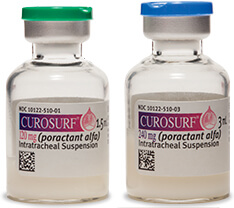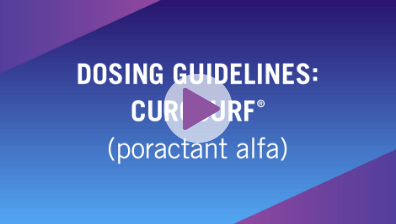When treating premature infants for Respiratory Distress Syndrome (RDS)
CUROSURF® (poractant alfa)
Why choose CUROSURF for your NICU?
†Not established to result in superior safety or efficacy.

The #1 Surfactant Used in US NICUs6‡
With more than 25 years of clinical research and more than 4.2 million infants treated worldwide, CUROSURF is used by more NICUs than any other surfactant.6,7
Why and When to Consider Early Rescue
The decision for early rescue with exogenous surfactant in respiratory distress syndrome (RDS) is multifactorial, based on both infant characteristics and maternal factors. Understanding those characteristics can help identify increased risk for CPAP failure, allowing proactive management in the NICU.8,9


CUROSURF® (poractant alfa) is intended for intratracheal use only. The administration of exogenous surfactants, including CUROSURF, can rapidly affect oxygenation and lung compliance. Therefore, infants receiving CUROSURF should receive frequent clinical and laboratory assessments so that oxygen and ventilatory support can be modified to respond to respiratory changes.
CUROSURF should only be administered by those trained and experienced in the care, resuscitation, and stabilization of preterm infants.
Transient adverse reactions associated with administration of CUROSURF include bradycardia, hypotension, endotracheal tube blockage, and oxygen desaturation. These events require stopping CUROSURF administration and taking appropriate measures to alleviate the condition. After the patient is stable, dosing may proceed with appropriate monitoring.
Pulmonary hemorrhage, a known complication of premature birth and very low birth-weight, has been reported with CUROSURF. The rates of common complications of prematurity observed in a multicenter single-dose study that enrolled infants 700–2000 g birth weight with RDS requiring mechanical ventilation and FiO2 ≥ 0.60 are as follows for CUROSURF 2.5 mL/kg (200 mg/kg) (n=78) and control (n=66; no surfactant) respectively: acquired pneumonia (17% vs. 21%), acquired septicemia (14% vs. 18%), bronchopulmonary dysplasia (18% vs. 22%), intracranial hemorrhage (51% vs. 64%), patent ductus arteriosus (60% vs. 48%), pneumothorax (21% vs. 36%) and pulmonary interstitial emphysema (21% vs. 38%).
CUROSURF® (poractant alfa) Intratracheal Suspension is indicated for the rescue treatment of Respiratory Distress Syndrome (RDS) in premature infants. CUROSURF reduces mortality and pneumothoraces associated with RDS.
CPAP=continuous positive airway pressure; FiO2=fraction of inspired oxygen; NICU=neonatal intensive care unit.
References: 1. Speer CP, Gefeller O, Groneck P, et al. Arch Dis Child. 1995;72(1):F8-F13. 2. Collaborative European Multicenter Study Group. Pediatrics. 1988;82(5):683-691. 3. Ramanathan R, Rasmussen MR, Gerstmann DR, Finer N, Sekar K; North American Study Group. Am J Perinatol. 2004;21(3):109-119. 4. Verder H, Albertsen P, Ebbesen F, et al. Pediatrics. 1999;103(2):E24. 5. Gerdes JS, Seiberlich W, Sivieri EM, et al. J Pediatr Pharmacol Ther. 2006;11(2):92-100. 6. IQVIA Global Market Share, Total Year 2018. 7. Data on file, Chiesi Farmaceutici S.p.A. and Chiesi USA, Inc. 8. Nanda D, Nangia S, Thukral A, et al. Eur J Pediatr. 2020;179(4):603-610. 9. Tian T, Wang L, Ye R, et al. Pregnancy Hypertens. 2020;19:131-137.

